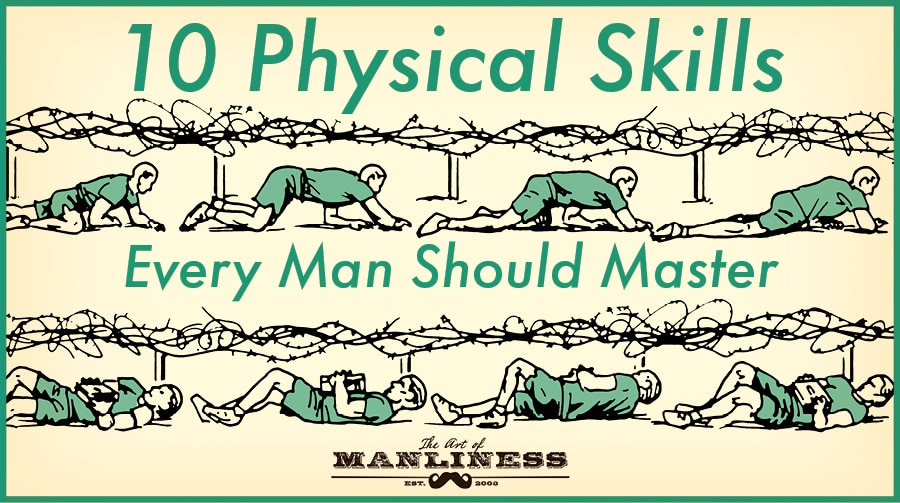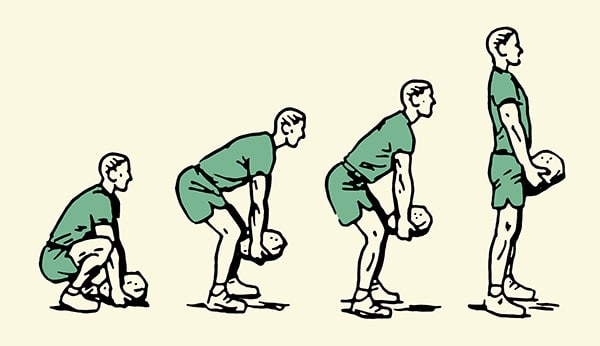With our archives now 3,500+ articles deep, we’ve decided to republish a classic piece each Friday to help our newer readers discover some of the best, evergreen gems from the past. This article was originally published in May 2017
You probably started crawling when you were about nine months old, and walking at a year. You likely got running around a year later, and learned how to jump not long after that. In the months and years that followed, you got the hang of many other physical movements that helped you explore your world, play with friends, and make it through PE class.
Now that you’re a grown man, you probably don’t think all that much about the different ways you can move your body (unless it’s to note how much more painful some of them feel these days). After all, you’ve been doing such thoroughly simple things like running and jumping for decades now, and they feel completely instinctual. You don’t have to think much about basic physical movements anymore.
That’s the common line of thinking, at least. But it’s a wrong-headed and detrimental perspective.
That which we believe is “basic” turns out to have layers of complexity we simply haven’t discovered yet.
And while we don’t typically think about them as such, physical movements are skills, and like all skills, they need to be deliberately, regularly, and continually practiced and challenged in order to stay in fighting shape and truly be mastered.
What It Means to Truly Be Physically Skilled
While it’s true that many physical movements are instinctual, and that most men can do them effectively, simply being able to get a job done is not the same thing as doing that job well; having an aptitude for something is not the same thing as being skilled in it.
I can whittle the end of a stick into a sharp point, but that aptitude for carving does not make me a master woodworker.
Likewise, it’s possible to be both physically fit and physically effective, without being physically proficient and efficient. That is, you can possess the ability to perform certain movements well enough to get by, without having refined your technique; you can be well-conditioned and have strength and endurance in spades, without being adept at moving in ways that enhance fluidity, conserve energy, and minimize injury.
It’s also possible to achieve functional fitness without achieving adaptable fitness.
Programs like CrossFit have valuably brought the former category to the fore, and encouraged folks to exercise their bodies in ways that aren’t limited to using Nautilus machines and dumbbells. But even these “functional” workouts are relatively limited and circumscribed in scope. They don’t entirely translate to the environmental and situational demands one faces outside the metaphorical and literal box.
You can do a bunch of plyo box jumps in the gym, but how many landings could you stick in nature, where rocks and ledges don’t have a uniform shape, height, or surface? You can do a dozen pull-ups on a bar, but would you be able to pull yourself up even once on a tree branch? You can carry a sandbag back and forth across a parking lot, but would you be able to carry another person uphill, and over obstacles and debris? You can lift a barbell, but can you lift and shoulder a thick, rough, uneven log? You can run a mile on a treadmill in an air-conditioned environment, but can you run in the wind and the rain — in sweltering heat and frigid cold?
The goal for a man’s physicality should eschew narrowness in favor of an expansiveness that incorporates all of these qualities: effectiveness and efficiency; fitness and proficiency; functionality and adaptability.
A man should be able not only to perform a wide range of movements, but to do so with the best possible technique; he should be able to perform not only a high quantity of movements, but a high quality of them as well. He should not only be able to move, but to move with finesse. And he should be able to perform such movements not only within a gym, but in a variety of terrains, environments, and weather conditions, across a wide range of surfaces, heights, and distances.
Gaining mastery in all of these areas is to become physically well-rounded, or as the MovNat (“natural movement”) system, from which the above philosophy derives, puts it: the goal should be to gain “physical competence for practical performance.”
To truly become physically skilled.
Listen to our podcast with MovNat founder Erwan Le Corre:
The Practice of Physicality
Physical movements are skills and like all skills, they require practice to master; you may have been born with a natural aptitude for certain movements, but that potential then needs to be intentionally honed and sharpened. A man’s body is both tool and master; with the right level of discipline, knowledge, and dedicated practice, it can be put to an extraordinary, and even inspiring, number of uses.
Practicing physical skills is like practicing any other skills in that you must first master the very fundamentals, and from there strive to steadily increase the level of difficulty you can handle. This requires working in the following areas:
- Technique: Technique involves mindfully using the best body position, form, tension, breathing, etc. to execute a movement efficiently – in a way that expends less energy, increases speed/endurance/strength capacity, and prevents injury.
- Variations: Physical skills have many variations that call for varied techniques; for example, you can jump either vertically or horizontally; you can crawl with your belly on the ground or up on your hands and knees. The more variations you master, the more skilled you become in that movement.
- Volume & Intensity: It’s one thing to be able to perform a physical skill for one rep, or at a short distance. But true physical competence means possessing the ability to go short or long, easy or hard, light or heavy.
- Environmental/Situational Demands: Increasing the complexity of the environment in which you practice physical skills — training on various surfaces, heights, and even in various mental states — makes performing a physical movement more challenging and the skill you earn in that area more adaptable.
Now that you know physical skills must be practiced, and how they are practiced, the next question, of course, is what set of skills you ought to be practicing.
The 10 Physical Skills Every Man Should Master
While there are many ways that the human body can move, there are arguably 10 skills that form the very essentials of physical competence: balancing, running, crawling, jumping, climbing, traversing, lifting, carrying, throwing, and catching. These skills form the backbone of the MovNat system, and are also very similar to the essential “military physical skills” delineated in the Marines Physical Readiness Training for Combat manual – movements the “Fast and skillful execution” of which, “may mean the difference between success and failure on the battlefield.” These are the skills that will allow you to ably carry out day-to-day tasks, save yourself and others in emergencies, and navigate your environment with confidence, and even exhilaration.
Below we provide a brief introduction to the 10 physical skills every man should master, with descriptions and illustrations based on the (incredibly informative) Level I MovNat Certification manual. The article is designed to provide a broad overview of each skill, covering its practical applications, some of its possible variations, and ways to challenge yourself and level up in that area.
The illustrations demonstrate the very basics of these movements, as well as some of their variations. There isn’t room in this article to show every variation of every skill, nor to offer step-by-step instructions on technique; text is not the best way to learn physical technique besides. In many cases, I’ve linked to very brief demonstrations of these skills by MovNat’s founder, Erwan Le Corre. But to really develop your technique, I recommend getting in-person coaching by attending a MovNat workshop or certification (you can read my review of it here).
(I have no financial affiliation with MovNat — I just dig their philosophy and approach to physicality; they’re the masters of mastering physical skill.)
Balancing
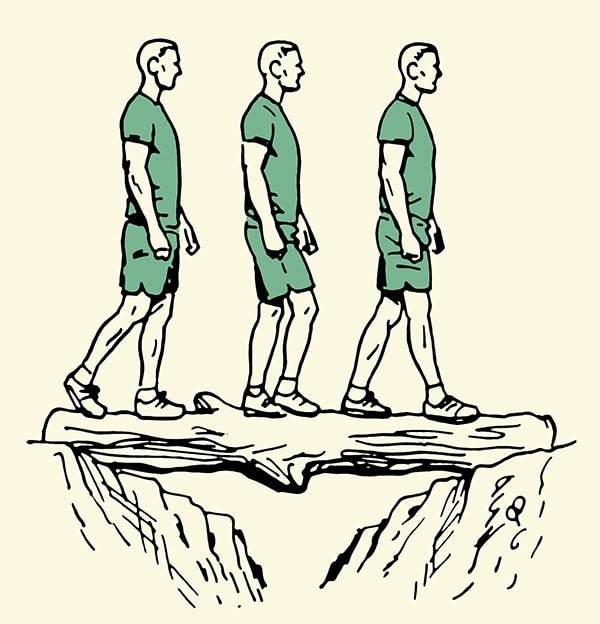
Even when you’re just standing up, you’re countering and managing the forces of gravity, and thus balancing. Ditto for every movement you make. Balance as a skill, however, involves a more challenging context, when a surface you’re navigating is more unstable, slippery, and most typically, narrower than those you typically encounter, e.g., crossing a log or railing.
Because balancing is often engaged in a slower way, and is thus neither as taxing nor strengthening to one’s anaerobic or aerobic systems as other exercises, it’s often overlooked as an important physical skill. But it’s not only a central component of all movement, it also improves joint stability and enhances mindfulness; the focus required to maintain balance reconnects the mental and physical. Plus, it’s a skill that surely comes in handy when the only way to cross a river, chasm, or other obstacle is by way of a narrow beam.
Balancing is an easy skill to practice in short snatches throughout the day; I’ve in fact got a 2X4 in my living room just for this purpose.
Ways to Practice, Challenge, and Level Up This Physical Skill
- Practice basic balancing with good technique
- Move backwards and sideways on the board/beam
- Pivot on the beam to change direction
- Practice standing on one foot on the beam
- Do a split squat on the beam and stand up without losing your balance
- Do a split squat on the beam and change directions
- Keep your balance while holding a static position (standing on two feet, one foot, crouching, etc.)
- Move quickly across the beam (without sacrificing technique)
- Cross a beam while carrying a weight like a sandbag
- Cross beams of varied heights
- Cross beams that are more narrow, slippery, unstable
- Catch or throw something while crossing the beam
- Perform any of the above right after a bout of strenuous activity/exercise, when your heart rate is elevated
Running

Running, along with walking, constitutes the most basic form of human locomotion. It also constitutes what is arguably the best form of full-body aerobic and anaerobic exercise. The conditioning that comes from running forms a necessary base for performance in numerous recreational activities, as well as team, individual, and combat sports. And whether you’re running to an emergency to lend aid, or away from it to summon help, running is key to surviving and thriving in crisis scenarios.
Running unfortunately also comes with a high rate of injury. While MovNat encourages running with a forefoot/midfoot strike, and even a progression to barefoot running as a way to lower this risk, I’m personally not bullish on people’s ability to significantly change their running form, nor convinced that the forefoot strike is necessarily best for everyone. Heel striking is overly demonized these days, and doesn’t even use more energy as is commonly supposed.
Certainly, improve what you can about your form (including cadence, stride length, and posture), but I believe the best and most effective way to prevent injuries is simply to run less, and “cross-train” more (MovNat encourages this approach as well). All the other exercises listed here, from jumping to balancing to lifting, will improve your all-around strength and agility, and help injury-proof your running. Running on varied surfaces, instead of exclusively on pavement and/or treadmills, will help greatly too.
Run as efficiently as you can.
Ways to Practice, Challenge, and Level Up This Physical Skill
- Practice running with good technique
- Vary speed, distance, and duration
- Run on varied surfaces – in the woods, on sand, etc.
- Practice dodging obstacles and quickly changing directions when you run
Crawling
Crawling is likely the first fundamental movement you developed as a baby. Yet as adults, it’s probably the most neglected, perhaps because it seems too “basic” to require practice as a grown-up. But it certainly isn’t.
For babies, crawling is an excellent on-boarding stage for the motor skill development to come, as it engages the whole body, and necessitates coordination between arms and legs. This function still serves adults well. Crawling requires contralateral movement (e.g., moving your right arm and left leg forward at the same time) – which is harder to do at first than you’d think! It encourages mindfulness about your body position, strengthens all your limbs and especially your core, enhances your limberness and agility, and, when performed over a significant distance, provides a great conditioning exercise too. Because of its whole-body benefits, Aaron Baulch, a MovNat instructor here in Tulsa, aptly calls crawling “body armor.”
Crawling is also eminently functional. It allows you to wriggle under low obstacles, keep moving while dangers (e.g., bullets) are present overhead, creep quietly, stalk animals and humans, and ascend/descend steep and slippery surfaces while maintaining balance.
Crawling can be performed with different combinations of hands, knees, feet, and even your backside in contact with the ground, depending on how low you want to get, how quickly you need to move, and whether you need to do things like carry equipment as you crawl.
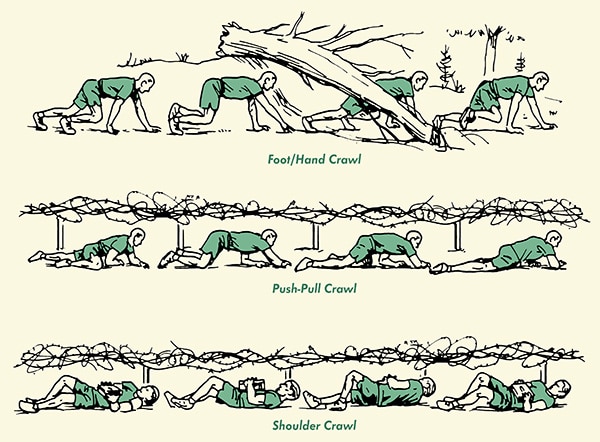
The Foot-Hand Crawl is a quick crawl good for climbing up a slippery incline and making fast transitions to standing or other movements on the ground. The Push-Pull Crawl is slower, but helps you get lower and closer to the ground. The Shoulder Crawl is slower than the Push-Pull, but uses less energy and allows you to see more of what’s going on around you, as well as carry something as you crawl.
Ways to Practice, Challenge, and Level Up This Physical Skill
- Crawl with hands, knees, and feet in contact with the ground (“Knee Hand Crawl“)
- Crawl with hands and feet in contact with the ground, but your knees elevated (“Foot/Hand Crawl“)
- Crawl with your forearms and legs in contact with the ground (“Push-Pull Crawl“)
- Crawl with your back on the ground, using your feet and shoulders (“Shoulder Crawl“)
- Crawl with your back on the ground while holding something on your belly/chest
- Practice crawling under very low obstacles
- Crawl across a narrow beam
- Crab (inverted) crawl
- Crawl uphill and downhill
- Crawl over long distances
- Vary the surfaces on which you crawl
Jumping
There’s a reason we associate jumping with joy; it’s a very freeing movement that allows you to momentarily escape the forces of gravity. But it’s also a very functional movement: whether you’re jumping across a creek, over an obstacle in your path, downwards from a ledge, or upwards to grab a piece of fruit off a tree, jumping allows you to confidently explore complex and difficult environments.
It’s a movement with a great impact on your physiology as well, increasing your body’s work capacity and power. For this reason it’s a staple of athletic training, especially for those in sports that are high in intensity.
There are two parts to the skill of jumping — leaving the ground and landing. The latter is even more important than the former; you need to know how to land in a way that absorbs and disperses the forces of impact, both to minimize the impact of those forces on your body, and to maintain your balance as you hit the ground. For that reason, it’s best to learn the technique of landing before you start working on the technique of jumping itself.
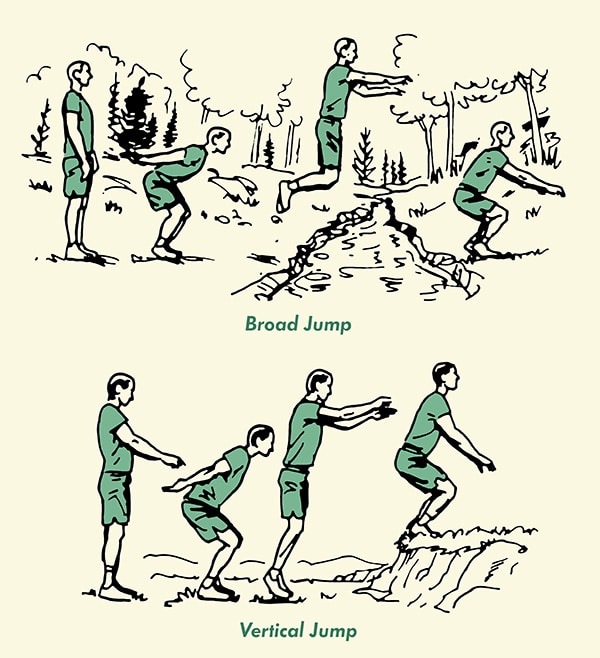
Ways to Practice, Challenge, and Level Up This Physical Skill
- Practice “depth jumping” to work on your landing skill; climb on top of a low box/obstacle and “jump” down (you don’t need to do much real jumping; just lean forward on the edge and let gravity take care of the rest)
- Practice broad jumping for distance; you can use two weight plates for this purpose – jump from one and land on the other, varying the distance between the plates
- Practice vertical jumping for height; vary the heights of your jumps
- Practice jumping with one leg
- Vary the texture, evenness, and stability of the surfaces you jump to and from — start from grass and jump onto a rock; jump from rock to rock; jump between wet and slippery rocks, etc.
- Vary the area of the surfaces you jump to and from – try to “precision jump,” to and/or from narrow areas; e.g., jump from one 2X4 to another or one railing to another
Climbing
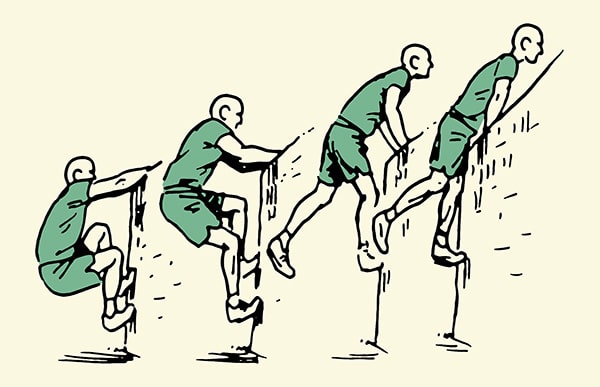
Climbing is a uniquely satisfying and joyful activity. Perhaps it’s because of the way it calls upon all four of your limbs, or the thrill of leaving the earth and scaling a height, or the challenge of managing your bodyweight and fighting the forces of gravity. Part of the interest it holds is surely due to the fact there are so many different things to climb — rock faces, pipes, fences, walls, cargo nets, ladders – each providing a fresh challenge and a very tangible obstacle to surmount. Any way you slice it, climbing simply feels wonderfully exploratory, and even makes you temporarily feel like a different kind of creature.
The fun of climbing is accompanied by serious physical benefits: it works your whole body, improving your strength, work capacity, and agility.
Proper technique in climbing is important both from a safety and an energy conservation standpoint, and extends to things you probably don’t think of as even having a technique, like hanging. There’s definitely a best way to hang, and it’s a skill not only important for climbing but for traversing as well.
Ways to Practice, Challenge, and Level Up This Physical Skill
- Do a dead hang from a bar or hang from the edge of a wall as long as you can
- Perform a climb-up/muscle up where you hang from the top of a wall and then push yourself up and over it
- Perform a muscle up on a bar or tree branch
- Hold on to the structure/wall you’re climbing with just one hand; bonus points for performing another task with your free hand
- Vary the heights of the structures you climb
- Vary the surfaces/textures/material/construction of the structures you climb (rock, ropes, nets, walls, trees, pipes, etc.)
Traversing
Traversing is essentially horizontal climbing. While you swung across the monkey bars with ease as a boy because of your ideal strength-to-weight ratio, traversing is a lot more challenging when you’re a grown man who’s got to move a lot more height and poundage. This enhanced challenge extends to the fact that you ought to be skilled in traversing more structures than just monkey bars, because, let’s face it, horizontal ladders do not abound in either wild or urban landscapes. You’re more likely to find yourself making your way across a pipe laid between buildings or a rope strung over a river.
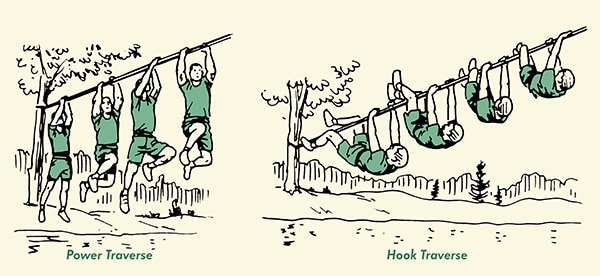
The Power Traverse is quick and explosive, but because it uses only the hands, it expends more energy and fatigues the upper body. The Hook Traverse, which use both the hands and the legs, is slower, but conserves energy and gives one a stronger and safer hold of the surface.
Ways to Practice, Challenge, and Level Up This Physical Skill
- Traverse a horizontal ladder with a “front swing” — your body facing forward, and swinging back and forth
- Traverse a horizontal ladder or a single beam/pipe/rope with a “side swing” — your body parallel to the ladder’s side railings, both hands gripping the same railing and swinging side-to-side
- Traverse a structure with a front or side “Power Traverse,” moving hand over hand
- Traverse a structure with the “Hook Traverse”
- Vary the width and texture of the structure you traverse
- Vary the height and/or length of the structure you traverse
- Traverse with added weight (like wearing a backpack)
Lifting
There are many reasons for a man to be strong, not the least of which is the fact that strength is the foundation of fitness. It allows you to do all other movements in a more robust and versatile way, with less chance of injuries. While all physical skills build strength to greater and lesser degrees, lifting does so in the most focused way.
What’s less appreciated about strength, however, is that the equation works the other way around too: the ability to move increases strength. The more flexible and agile you are — and these qualities are built not just from, or even most effectively from, actual stretching but from practicing the widest possible range of physical skills — the easier you can get into the proper positions for lifting. Because lifting is definitely not only about sheer force and exertion, but technique as well. Technique — and this concerns things like posture, tension, and breathing — conserves energy, allowing you to lift more, and staves off injuries.
The strength gained from lifting not only translates into direct use — e.g., lifting debris that’s fallen on someone — but as preparation for segueing into another movement — e.g., lifting a bag of mulch, that you then carry into the backyard. In either case, it pays for your lifting capability to be expansive not only in sheer strength (the number of pounds you can hoist), but in versatility. You may be very adept at lifting a bar while standing on rubber matting, but you should also be skilled in lifting rough and oddly-shaped objects — rocks, logs, and even people themselves – while standing on dirt, sand, and other uneven ground.
Ways to Practice, Challenge, and Level Up This Physical Skill
- Practice lifting with good technique
- Lift objects of varied evenness, texture, size, and weight (including people)
- Vary the surface of the ground you stand on while you lift
Carrying
While lifting comes in for the lion’s share of attention and glory in the modern fitness landscape, the ability to carry the things you lift is just as important, and even more practical. Whether you’re lifting cement, sandbags, or grocery sacks off the floor, your toddler out of bed, or your comrade off the battlefield, you typically don’t hoist them and stand there in a static position — you carry them over to where you need them to be.
Carrying calls on a type of strength that most of us don’t exercise much, either in the gym or our day-to-day lives, and thus training this capacity must be intentional, and the proper technique for how to hold and grip a load must be studied and learned.
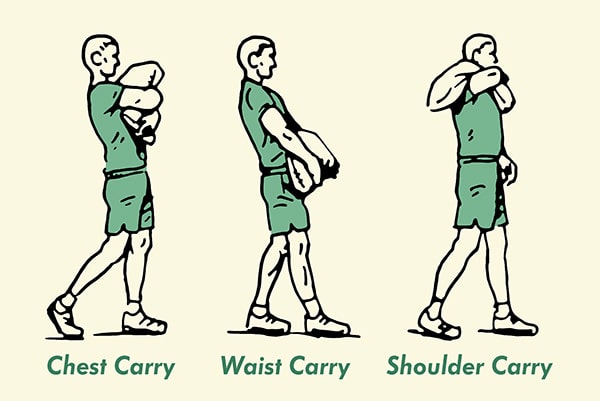
Ways to Practice, Challenge, and Level Up This Physical Skill
- Practice various carry techniques – Waist, Shoulder, Chest
- Practice switching a load (like a log) from one shoulder to the other
- Practice squatting with a load on your shoulder
- Practice various carrying grips
- Practice carrying objects of varied evenness, texture, size, and weight (including people)
- Vary the surface you walk/run/march on as you carry the object
- Carry an object while straddling or crawling under a hurdle/obstacle
- Carry objects for long distances
Throwing and Catching
Throwing and catching are two distinct physical skills, but I’ve combined them here because they typically go together: though you sometimes throw objects aside to get them out of your path, you’re most often throwing an object to someone who will catch it, and you don’t catch something that hasn’t been thrown! So too, many of the movements used to throw and catch are essentially mirror images of each other.
Throwing and catching serve as a big part of many organized sports, but they also have many practical and even survival uses. Farmers throw hay bales; soldiers toss equipment over a wall or to each other. If facing a flood, you’d throw and catch sandbags on down the line to build up a barricade; if lost in the woods, the ability to accurately throw a spear could keep you from starving.
The dynamic and cooperative nature of throwing and catching, as well as the need for focus and reactivity, make it one of the more enjoyable physical skills to practice and execute. At the same time, practice of one’s throwing and catching skill set strengthens the core, and is highly beneficial to enhancing the mobility of one’s midsection, hips, and back – mobility that comes in handy for many other movements, including throwing a punch.
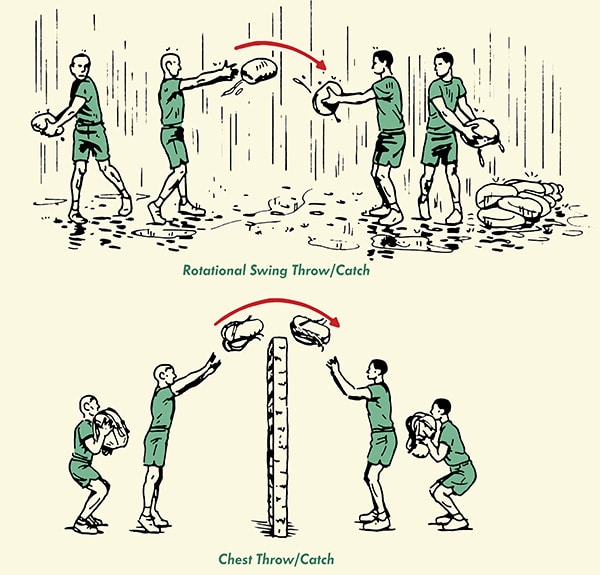
The Rotational Swing Throw comes into play for throwing things aside that are in your path, or for throwing things to someone else who will then cast them to the side; the catcher can smoothly catch objects thrown low, without it contacting their body. It’s not a good throw/catch for heavier objects, however. The Chest Throw can be engaged in while you’re moving, and is an accurate throw for getting something to, onto, or over something, while the catch allows you to handle an object coming directly at you, or from on high.
Ways to Practice, Challenge, and Level Up This Physical Skill
- Practice the Front Swing and Chest throwing/catching techniques
- Throw/catch objects of varied evenness, texture, size, and weight
- Vary the distance between the thrower and the catcher
- Throw/catch while kneeling
- Throw objects over a tall obstacle
- Vary the distance the object is held away from your body as you throw/catch
- Vary the side of your body that you throw/catch from
Moving Beyond the Physical Foundation
While the ten skills above represent the core of a man’s physical skill set, they hardly represent its limit. Once you’ve mastered the ground level of these “basic” movements, and added in variations in technique and complexity, you can work on other skills like vaulting and combatives (striking, grappling). And of course, you won’t just want to be physically competent on the land, but to become an amphibious animal who can deftly swim, dive, and explore the waters.
As you increase both the breadth and the depth of your physical skills, you will feel increasingly empowered to navigate your environment in ways that are sometimes practical, and other times simply playful, joyful, and creative. You’ll be confident in feeling like you could perform admirably in an emergency, while enjoying the day-to-day satisfaction that comes from mastering the skillful use of your greatest gift — your body.
Every man should know how to move naturally, and paradoxically enough, gaining the ability to do so, requires a whole lot of practice.
Illustrations by Ted Slampyak


